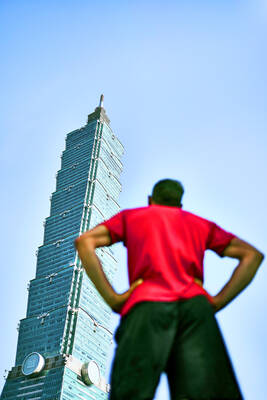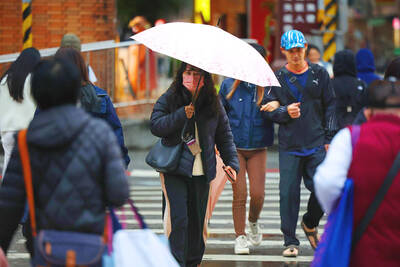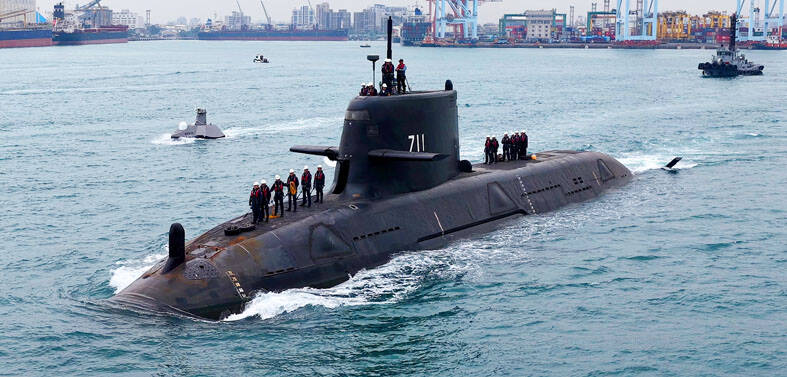While it has become customary for the government to hold a memorial each year to commemorate the victims of the 228 Massacre, not very many young people know what happened in the incident that inspired Taiwan’s democratic movement.
Determined to change that, 79-year-old painter Tung Jih-fu (董日福), who witnessed the bloody crackdown, decided to use the incident as an inspiration for his work and display his paintings this year to mark the 67th anniversary of the incident.
The 228 Incident refers to an uprising that erupted after a Taiwanese woman was beaten by Monopoly Bureau agents on Feb. 27, 1947, for selling contraband cigarettes in Taipei.

Photo: Huang Wen-huang, Taipei Times
The ensuing revolt led to the slaughter of tens of thousands of Taiwanese at the hands of Chinese Nationalist Party (KMT) troops.
Born in what was then Tainan in 1935, Tung lost both her parents in World War II and made a living shining shoes on the street.
Her uncle’s efforts to get him a job painting movie billboards at the now-demolished Yanping Theater in Tainan allowed him to discover his talent. After he served his mandatory military service, he became an apprentice to painter Kuo Po-chuan (郭柏川).
Tung also worked as a teaching assistant in Kuo’s studio, demonstrating basic sketching techniques to beginning students, an experience that later helped him secure a teaching position at National Cheng Kung University and National Taiwan University of Arts.
He is also renowned for his calligraphy, having won several accolades in national calligraphy competitions.
Most of Tung’s oil paintings have been well-received by critics, including the 12 that he exhibited in December 2012 depicting the various cultures of the 78 nations that he has visited.
However, he said his one regret was that he had never immortalized the KMT regime’s takeover of Taiwan in 1945 and the 228 Incident in his work.
Tung said he saw first-hand how the KMT government’s “habit of corruption” triggered the soaring inflation that eventually culminated in the Incident.
“The images of Mainlanders and native Taiwanese fighting on the streets of the capital’s Zhongzheng District (中正), of KMT troops brutally slaughtering innocent people and lawyer Tang Te-chang (湯德章) being executed in what was then Minsheng Park are still vivid in my mind,” Tung said.
Tang was a Japanese-Taiwanese lawyer working in Tainan when the KMT army arrested him on charges of sedition. He was severely beaten before being executed on March 13, 1947, in the park, which was renamed the Tang Te-chang Memorial Park in 1998 in his honor.
Tung’s bid to depict these events received support from Flomo Education Foundation founder Shen Kun-chao (沈坤照), who provided financial assistance to help the artist bring the works to life.
Inspired, Tung produced six paintings in one year: Soldiers with Straw Sandals (草鞋軍隊), An Era of Famine (糧荒時代), A Real Nightmare (真實噩夢), With My Own Eyes (親眼目睹), Inflamed With Anger (滿腔怒火) and A Historical Scar (歷史傷痕).
The painter said he hoped the contrasting colors of his works could remind people of the nation’s gruesome past, while at the same time encouraging the younger generation to respect their history.

US climber Alex Honnold is to attempt to scale Taipei 101 without a rope and harness in a live Netflix special on Jan. 24, the streaming platform announced on Wednesday. Accounting for the time difference, the two-hour broadcast of Honnold’s climb, called Skyscraper Live, is to air on Jan. 23 in the US, Netflix said in a statement. Honnold, 40, was the first person ever to free solo climb the 900m El Capitan rock formation in Yosemite National Park — a feat that was recorded and later made into the 2018 documentary film Free Solo. Netflix previewed Skyscraper Live in October, after videos

NUMBERS IMBALANCE: More than 4 million Taiwanese have visited China this year, while only about half a million Chinese have visited here Beijing has yet to respond to Taiwan’s requests for negotiation over matters related to the recovery of cross-strait tourism, the Tourism Administration said yesterday. Taiwan’s tourism authority issued the statement after Chinese-language daily the China Times reported yesterday that the government’s policy of banning group tours to China does not stop Taiwanese from visiting the country. As of October, more than 4.2 million had traveled to China this year, exceeding last year. Beijing estimated the number of Taiwanese tourists in China could reach 4.5 million this year. By contrast, only 500,000 Chinese tourists are expected in Taiwan, the report said. The report

Temperatures are forecast to drop steadily as a continental cold air mass moves across Taiwan, with some areas also likely to see heavy rainfall, the Central Weather Administration (CWA) said. From today through early tomorrow, a cold air mass would keep temperatures low across central and northern Taiwan, and the eastern half of Taiwan proper, with isolated brief showers forecast along Keelung’s north coast, Taipei and New Taipei City’s mountainous areas and eastern Taiwan, it said. Lows of 11°C to 15°C are forecast in central and northern Taiwan, Yilan County, and the outlying Kinmen and Lienchiang (Matsu) counties, and 14°C to 17°C

STEERING FAILURE: The first boat of its class is experiencing teething issues as it readies for acceptance by the navy, according to a recent story about rudder failure The Hai Kun (海鯤), the nation’s first locally built submarine, allegedly suffered a total failure of stern hydraulic systems during the second round of sea acceptance trials on June 26, and sailors were forced to manually operate the X-rudder to turn the submarine and return to port, news Web site Mirror Daily reported yesterday. The report said that tugboats following the Hai Kun assisted the submarine in avoiding collisions with other ships due to the X-rudder malfunctioning. At the time of the report, the submarine had completed its trials and was scheduled to begin diving and surfacing tests in shallow areas. The X-rudder,